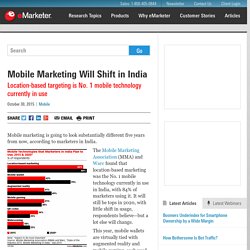

Yahoo escalates the war on ad-blockers — by keeping people out of their own e-mail. (Denis Balibouse/Reuters) Yahoo confirmed reports that it is preventing some Yahoo Mail users from seeing their own e-mails until they turn off their ad-blocking software.

Several reports have indicated that some U.S. users have tried to view their mail, only to receive a message from the site asking them to turn off their ad-blocking software first. In a statement to The Washington Post, a spokeswoman said, "At Yahoo, we are continually developing and testing new product experiences. This is a test we're running for a small number of Yahoo Mail users. " The move could be seen as a reaction to the growing use of ad blockers, which people are installing on their devices to get away from annoying, sometimes invasive, often inconvenient advertisements. The move has served as a wake-up call for some in the advertising industry. Advertisers admit it: ‘We messed up’ the Web. Wearable Usage Will Grow by Nearly 60% This Year. The next several years will continue to see double-digit growth in the number of Americans using wearable devices, according to eMarketer's first wearables forecast.

In 2015, 39.5 million US adults 18 and over will use wearables, including smartwatches and fitness trackers. That's a jump of 57.7% over 2014. While penetration among US adults is just 16.0% this year, eMarketer expects that to double by 2018, to 81.7 million users. eMarketer defines wearable users as those who wear accessories or clothing at least once per month that are embedded with internet-connected electronics and exchange data with a manufacturer or other connected device. Wearables are currently most popular among US adults between 25 and 44, who are the most involved in the movement toward data and fitness tracking. With the growth in Fitbit in 2014, the market was primarily dominated by females. Young Mobile Users Drive UK Social Media Usage US Bloggers Rely on Social Media Marketing to Drive Post Traffic.
Mobile Devices Bring Commerce Everywhere ... Really. October 30, 2015 |Retail & Ecommerce eMarketer senior analyst Cathy Boyle has called the behaviors associated with shopping on tablets “couch and pillow commerce,” and based on data from MasterCard and Critical Mix, there is at least some kind of pillow-based purchasing going on among nearly two in five digital buyers.

The August 2015 poll of adult digital buyers in North America found that 37% had purchased products digitally while they were in bed. And that was not the only unusual location they had hit the “buy” button from. Nearly a quarter had made digital purchases from the bathroom, and 4% said they had conducted ecommerce from the shower—presumably with the help of a serious protective case. A tiny, but nonzero, number had even bought digitally while at a funeral. Mobile Messaging to Reach 1.4 Billion Worldwide in 2015. Mobile phone messaging apps will be used by more than 1.4 billion consumers in 2015, up 31.6% on the previous year according to eMarketer’s first ever worldwide forecast for these services.

Worldwide, that means 75% of smartphone users will use an over-the-top (OTT) mobile messaging app at least once a month in 2015. eMarketer defines mobile phone messaging apps as services that provide private one-to-one or one-to-many communication between registered users, where messages and calls are then transmitted via data connections and the mobile web.
Mobile phone messaging app users are individuals who make use of such services on at least a monthly basis. The growth in popularity of messaging apps is projected to continue, and eMarketer predicts that by 2018, the number of chat app users worldwide will reach 2 billion and represent 80% of smartphone users. On a regional basis, OTT messaging apps have shown heavy usage in Asia-Pacific, where 58% of the world’s messaging app population lives. Artificial intelligence: ‘Homo sapiens will be split into a handful of gods and the rest of us’ If you wanted relief from stories about tyre factories and steel plants closing, you could try relaxing with a new 300-page report from Bank of America Merrill Lynch which looks at the likely effects of a robot revolution.

But you might not end up reassured. Though it promises robot carers for an ageing population, it also forecasts huge numbers of jobs being wiped out: up to 35% of all workers in the UK and 47% of those in the US, including white-collar jobs, seeing their livelihoods taken away by machines. Haven’t we heard all this before, though? From the luddites of the 19th century to print unions protesting in the 1980s about computers, there have always been people fearful about the march of mechanisation. And yet we keep on creating new job categories.
“The poster child for automation is agriculture,” says Calum Chace, author of Surviving AI and the novel Pandora’s Brain. Retail Ecommerce and Mobile Sales Grow in South Korea. October 28, 2015 |Retail & Ecommerce The total retail market in South Korea is barely budging, but it’s a whole other world online—and especially on mobile—according to July data.

Statistics Korea (KOSTAT) reported that as of July, total retail sales were up by just 0.5% year over year in the country. Business-to-consumer (B2C) ecommerce sales, however, grew more than 40 times as fast over the same period. On mobile, growth was even more rapid, amounting to a nearly 64% increase in sales between July 2014 and July 2015.
Digital growth was fastest for agricultural products, pet items and the food and beverage sector, KOSTAT reported. For the full year, eMarketer anticipates 11.0% growth in retail ecommerce sales in South Korea, excluding digital sales of travel products and services. Young Mobile Users Drive UK Social Media Usage. Social networking has been a majority behavior among UK internet users for several years.

Add mobile’s influence to the mix and users are provided with more access anytime and anywhere. Programmatic Ad Spend in Japan Reaches Mobile Tipping Point. October 29, 2015 |Media Buying Based on August estimates from Voyage Group and Digital InFact (DIF), mobile will surpass the desktop for programmatic digital display ad spending in Japan this year.

The milestone comes amid stagnating programmatic spending on ads served to desktop and laptop PCs—and rapidly growing programmatic spending on smartphone ads. Mobile Marketing Will Shift in India. October 30, 2015 |Mobile Mobile marketing is going to look substantially different five years from now, according to marketers in India.

The Mobile Marketing Association (MMA) and Warc found that location-based marketing was the No. 1 mobile technology currently in use in India, with 84% of marketers using it. Marketers More Optimistic About Data-Driven Revenues. Marketers are spending more on—and generating more revenues from—their data-driven marketing efforts, according to a survey conducted in July 2015.

The Direct Marketing Association (DMA) found that revenues generated by data-driven marketing grew for 45.7% of US marketers between Q1 and Q2 2015, with 9.0% saying they grew significantly. What’s more, respondents thought data-driven marketing would be even better for revenues in the future. When the DMA asked about expected changes in such revenues between Q2 and Q3, a majority of respondents (54.3%) said their organization’s revenues from data-driven marketing would go up.
The share expecting significant increases also rose, to 11.0%.. Instagram's Mobile Ad Revenues To Hit Nearly $3B By 2017 07/28/2015. While its popularity is plain to see, Instagram’s financial picture has been harder to make out. Yet new projections from eMarketer put the Facebook unit in a most flattering light. Mobile Payments Will Triple in the US in 2016. The number of people in the US using their phones to pay for goods and services at the point of sale will continue to climb steadily, with 2016 being a year of significant growth for the technology.
According to the latest proximity mobile payments forecast from eMarketer, the total value of mobile payment transactions in the US will grow 210% in 2016. Mobile Accounts for Almost Half of China's Retail Ecommerce Sales. It's No Myth: Robots and Artificial Intelligence Will Erase Jobs in Nearly Every Industry. With the unemployment rate falling to 5.3 percent, the lowest in seven years, policy makers are heaving a sigh of relief. Indeed, with the technology boom in progress, there is a lot to be optimistic about. Manufacturing will be returning to U.S. shores with robots doing the job of Chinese workers; American carmakers will be mass-producing self-driving electric vehicles; technology companies will develop medical devices that greatly improve health and longevity; we will have unlimited clean energy and 3D print our daily needs. The cost of all of these things will plummet and make it possible to provide for the basic needs of every human being.
I am talking about technology advances that are happening now, which will bear fruit in the 2020s. But policy makers will have a big new problem to deal with: the disappearance of human jobs. It is imperative that we understand the changes that are happening and find ways to cushion the impacts. True, we are living better lives.